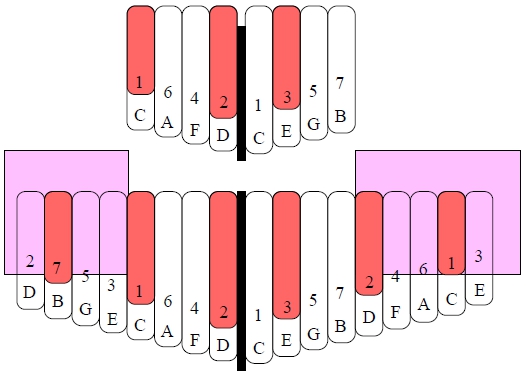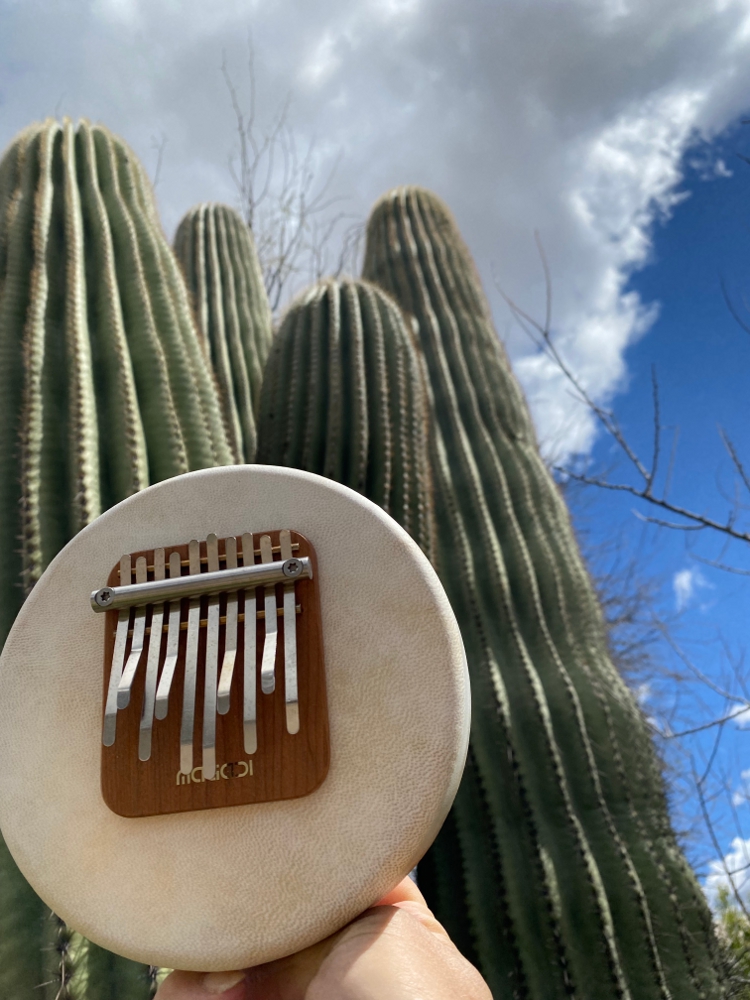
Use of this website constitutes acceptance of the Privacy Policy and User Agreement. Copyright © 2020 Kalimba Magic. All Rights Reserved.
Two years ago, I made a video demonstration of my kalimba tablature (which I originally created in 2004 to facilitate learning and sharing music on kalimba), playing Greensleeves on the 8-Note kalimba. The illustration at the top of this article is from that video. Three of the kalimba’s tines were painted red, and the three corresponding columns in the tablature were also colored red – the tablature is a replica of the kalimba, and each column represents a different tine.
What if you loved “Greensleeves” and wanted to play it on your 17-Note kalimba? Is it even possible to transfer music for one kalimba to a different one? Generally, you cannot play 17-Note kalimba music on an 8-Note kalimba; it just doesn’t have all the notes you likely need. But you can generally do the opposite, which is to play 8-Note kalimba music on your 17-Note kalimba… if one crucial thing is true: that the 17-Note has tines painted in the same logical scheme. And this is possible even though the 17-Note is in C and the 8-Note is in D. Tine painting can make all things possible!
Essentially every diatonic kalimba I own has tines painted in the scheme I just described. When I pick one up, I know exactly where I am on the kalimba just by looking at the colored tines. I know where to find all my notes, where to start a song. It’s not totally universal, though – not every kalimba will fit into my tine-painting scheme. Some are idiosyncratic, and don’t have painted tines – such as the Sansula or karimba. These are handled in different ways.
Now back to the 8-Note and its big brothers. If I know a song on the 8-Note kalimba, I can pick up a 15-Note or 17-Note kalimba and actually read the notes right off the 8-Note tablature. Both sonically and visually these kalimbas talk to each other.
You see, the notes of most 8-Note kalimbas are, from low to high: C D E F G A B C. These notes also happen to be the first eight notes of the 17-Note kalimba in C. Equally important: those notes are arranged exactly the same way, with the low note in the center, then alternating left-right-left-right as you go up the scale. And the clincher: in both the 8-Note kalimba and the 17-Note in C, the low D and E are painted, and the high C is painted. When these conditions are all met (as they are on every 17-Note Heart kalimba that we sell), you can transfer the notes from 8-Note tablature to the lower eight notes of the 17-Note.
If all the tines on a 17-Note are confusing you, get some little sticky notes, cut to size, and cover up the four left-most tines of your 17-Note, as well as the five right-most tines(as shown in the diagram below). What is left, the central eight notes, is a perfect match to the 8-Note kalimba.
The video at the bottom of this page was made with a Goshen kalimba in D which means it will sound different from the Alto in G or the 17-Note in C. However, the Goshen kalimba’s notes are arranged the same way, with 1 in the center, and 2 a painted tine to the left, and 3 a painted tine to the right. Even though each tine is tuned up a whole step in the video relative to a C kalimba (C is the most common key for kalimbas these days), you can still use the tablature, because the tablature doesn’t tell you which notes to play, but which tines to play. In this way it is a universal language.

Pink sticky notes cover up the extraneous tines and there is that 8-note core!
So, again, whether you have an Alto kalimba in G or a 17-Note kalimba in C, the central 8-notes on each will have the same numbers and the same painting scheme as the 8-Note kalimba. You can physically (with sticky notes) or mentally cover up the tines outside the central 8, and you can use tablature for the 8-Note to play those two larger kalimbas. They may sound different but the map to playing the music is right there. And here’s a trick to playing “Greensleeves” on a kalimba that isn’t in the key of D: watch the video below and then turn off the sound and play it again. You will be able to follow along on your own instrument in its own key.


Sign up for our newsletter and free resources with your email address:
We pinky promise not to spam you and to only send good stuff.
 Assist Paul Tracey Rebuild His House in Pacific Palisades
Assist Paul Tracey Rebuild His House in Pacific Palisades 8-Note Spiral Kalimba Turned into a Student Karimba
8-Note Spiral Kalimba Turned into a Student Karimba Seek to Infuse Your Musical Moments With Beauty and Magic
Seek to Infuse Your Musical Moments With Beauty and MagicUse of this website constitutes acceptance of the Privacy Policy and User Agreement. Copyright © 2020 Kalimba Magic. All Rights Reserved.